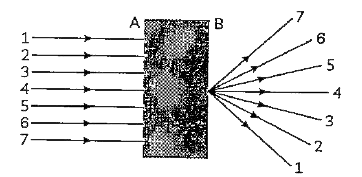Show diagrammatically, how should two converging lenses be arranged so that a parallel beam becomes parallel after passing through two lenses.
If the distance between two lenses becomes equal to sum of their focal lengths, then the parallel beam of light will emerge parallel after passing through the second lens.

Topper's Solved these Questions
- BOOK - VK GLOBAL PUBLICATIONCHAPTER - LIGHT-REFLECTION AND REFRACTIONEXERCISE - SHORT ANSEWR QUESTIONS-I16videos
LIGHT-REFLECTION AND REFRACTION
- BOOK - VK GLOBAL PUBLICATIONCHAPTER - LIGHT-REFLECTION AND REFRACTIONEXERCISE - SHORT ANSEWR QUESTIONS-II12videos
LIGHT-REFLECTION AND REFRACTION
- BOOK - VK GLOBAL PUBLICATIONCHAPTER - LIGHT-REFLECTION AND REFRACTIONEXERCISE - NCERT Exercises17videos
LIGHT-REFLECTION AND REFRACTION
- BOOK - VK GLOBAL PUBLICATIONCHAPTER - ELECTRICITYEXERCISE - SOME IMPORTANT NUMERICALS12videos
ELECTRICITY
- BOOK - VK GLOBAL PUBLICATIONCHAPTER - MAGNETIC EFFECTS OF ELECTRIC CURRENTEXERCISE - HOTS (Higher Order Thinking Skills)22videos
MAGNETIC EFFECTS OF ELECTRIC CURRENT
Similar Questions
A parallel beam of rays is incident on a convergent lens with a focal length of 40cm. Where should a divergent lens with a focal length of 15cm be placed for the beam of rays to remain parallel after passing through the two lenses.
View SolutionA parallel beam of rays is incident on a convergent lens with a focal length of 40cm. Where a divergent lens with a focal length of 15cm be placed for the beam of rays to remain parallel after passing through the two lenses.
View Solution
Knowledge Check
- Question 1 - Select One
Two thin lenses may be combined so as to
Aproduce diminished image.Bproduce maginifed image.Cproduce magnified image.Dcancel image and no image is formed. - Question 2 - Select One
A convex lens of focal length 100 cm and a concave lens of focal length 10 cm are placed coaxialiy at a separation of 90 cm. If a parallel beam of light is incident on convex lens, then after passing through the two lenses the beam
AConvergesBDivergesCRemains parallelDDisappears - Question 3 - Select One
Lenses made of transparent materials such as glass or plastic with curved surfaces. Diverging lenses are thicker at their edges than at their centres and make light rays passing through them spread out. Converging lenses are thicker in middle than at edges and make light rays passing through them focus at a point.
For lenses I and IIAP1=P2BP1<P2CP1>P2DP1 is positive and P2 is negative
An arrangement of a concave and a convex lens is shown below. The focal length of the convex lens is 30 cm. Parallel rays coming from a distant source are focused on the screen after passing through the lenses. Calculate the focal length of the concave lens.
 View Solution
View SolutionTwo convex lenses, of focal lengths 20 cm and 10 cm, respectively are separated by a distance of x cm. If a parallel beam of light remain parallel after refraction through both the lenses find x.
View SolutionA convex lens of focal length 100 cm and a concave lens of focal length 10 cm are placed coaxialiy at a separation of 90 cm. If a parallel beam of light is incident on convex lens, then after passing through the two lenses the beam
View SolutionLenses made of transparent materials such as glass or plastic with curved surfaces. Diverging lenses are thicker at their edges than at their centres and make light rays passing through them spread out. Converging lenses are thicker in middle than at edges and make light rays passing through them focus at a point.
Abhishek uses two lenses I and II of same size and same material as shown P1 and P2 are the powers of A and B. An object is kept at the same distance from the lenses between Fand 2F of each lens on the principal axis in turn Let li and la be the image formed by two lenses respectively. Which one of the following statements is correct for the images formed?
 View Solution
View SolutionLenses made of transparent materials such as glass or plastic with curved surfaces. Diverging lenses are thicker at their edges than at their centres and make light rays passing through them spread out. Converging lenses are thicker in middle than at edges and make light rays passing through them focus at a point.
A beam of light is incident on the box through the holes on side A and emerges out of the holes on the side B of the box:

Which of the following is present the boxView Solution

